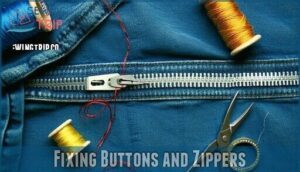This site is supported by our readers. We may earn a commission, at no cost to you, if you purchase through links.
 You can tackle most wardrobe mishaps with basic sewing projects for clothing repair that’ll save you serious cash.
You can tackle most wardrobe mishaps with basic sewing projects for clothing repair that’ll save you serious cash.
Start with simple fixes like reattaching loose buttons, hemming pants that drag on the ground, and patching small holes before they become gaping tears. Don’t toss that favorite shirt just because of a broken zipper—replacing it takes about fifteen minutes and costs under five dollars.
Basic alterations like taking in loose seams or adding darts can make ill-fitting clothes look custom-tailored. These skills turn clothing emergencies into quick weekend projects, keeping your wardrobe fresh without breaking the bank.
The real game-changer comes when you master invisible mending techniques, which can save you serious cash and make your clothes look like new, and with skills like basic sewing projects and simple fixes, you can tackle most wardrobe mishaps, and by doing quick weekend projects, you keep your wardrobe fresh.
Table Of Contents
Key Takeaways
- You’ll save serious money by mastering basic repairs like reattaching buttons, hemming pants, and patching small holes—these simple skills prevent you from tossing perfectly good clothes.
- You can transform ill-fitting garments into custom-tailored pieces through basic alterations like taking in seams and adding darts, turning weekend projects into wardrobe upgrades.
- You’ll extend your favorite clothes’ lifespan by catching problems early—fixing a loose button takes two minutes, but replacing an entire shirt costs twenty dollars.
- You can turn damaged clothing into unique fashion statements using advanced techniques like decorative patches, embroidery, and upcycling projects that make repairs look intentional.
Clothing Repair Basics
Before you toss that torn shirt or loose-buttoned jacket into the donation pile, you can easily fix most clothing problems with basic sewing skills.
Learning simple repair techniques like hemming, patching, and button replacement will save you money and keep your favorite clothes in your closet longer.
Essential DIY Repair Techniques
With just a needle and thread, you’ll master DIY clothing repair that saves money and favorite pieces.
Essential sewing techniques include button fixes for loose fasteners, seam reinforcement to prevent further tearing, and zipper repair for stuck mechanisms.
These clothing repair projects also cover elastic replacement in waistbands and lining repair for torn pockets.
Start with simple tears and loose buttons—they’re perfect practice for building confidence.
For more thorough fixes, consider using a button replacement kit.
Master these fundamental clothing repair techniques, and you’ll handle most wardrobe emergencies.
Your sewing projects for clothing repair begin with these core skills.
Extending Garment Lifespan
Once you’ve learned basic repair skills, extending your clothes’ lifespan becomes your next smart move.
Fabric Quality matters, but proper Washing Techniques matter more – cold water and gentle cycles protect fibers from breaking down prematurely.
Storage Solutions like breathable garment bags and cedar blocks keep moths away while preventing fabric stress.
Repair Frequency plays a huge role in clothing longevity.
Fix small issues before they become big problems.
A loose button takes two minutes to secure, but replacing an entire shirt costs twenty dollars.
Smart Clothing Maintenance includes regular inspections during laundry time.
These clothing repair techniques and clothing repair projects support Sustainable Fashion by keeping garments functional longer, reducing your need to buy replacements constantly.
Saving Favorite Clothes
Your grandmother’s vintage dress or that concert t-shirt holds sentimental value beyond its fabric.
Mending memories through clothing repair transforms repairing heirlooms into meaningful sewing projects. Simple clothing fixes like patching tears or reinforcing seams preserve these treasures for years.
DIY clothing repair techniques help maintain wardrobe longevity while embracing sustainable fashion. Clothing mending saves pieces that money can’t replace—those irreplaceable favorites deserve professional-level care.
Alteration Fundamentals
Three simple measurements reveal the door to perfect-fitting clothes: chest, waist, and hips. Start there, and you’ll save yourself from costly tailoring bills.
Master three measurements—chest, waist, hips—and unlock perfectly fitted clothes without the tailor’s price tag.
Fit adjustments begin with understanding your body’s unique shape. Grab a flexible measuring tape and have someone help you get accurate numbers. Write them down – you’ll reference these constantly.
Seam construction varies by fabric type, so test your techniques on scraps first. Cotton behaves differently than stretchy knits, and your sewing alteration techniques need to match the material.
Pattern alterations and draping techniques sound fancy, but they’re just ways to reshape fabric around your body. Pin carefully, try on frequently, and make small adjustments rather than dramatic changes.
Fabric manipulation through garment alterations transforms ill-fitting pieces into wardrobe favorites. Whether you’re altering clothing size or fine-tuning the fit, remember the golden rule: measure twice, cut once. Your future self will thank you.
Simple Sewing Projects
You don’t need years of experience to tackle basic clothing repairs that’ll save you money and extend your wardrobe’s life.
Start with simple projects like hemming pants, replacing buttons, and fixing zippers – these straightforward skills will handle most common clothing problems you’ll encounter, which can be considered basic repairs.
Hemming Pants and Jeans
Instead of tossing those too-long jeans, you can master hemming techniques for perfect pant leg alterations at home. Measuring inseam accurately guarantees professional results every jeans repair project.
Here’s your hemming pants tutorial roadmap:
- Try on jeans and mark desired length with pins
- Cut excess fabric, leaving 1-inch seam allowance
- Choose between blind hemming for invisible stitches or visible topstitching
- Consider cuff options like rolling or folding for style variety
- Preserve the original hem when possible for authentic factory finish
A specialized tool, the blind hem foot, can simplify creating an invisible hem. Practice makes perfect with pants repair – soon you’ll hem like a pro.
Fixing Buttons and Zippers
After hemming comes the nitty-gritty of button replacement and zipper repair – two skills that’ll rescue countless garments from the donation pile.
For button repair, match your thread color and secure with a sturdy knot. Button reinforcement prevents future mishaps by adding extra stitches around the base.
Broken zippers need different tactics. Try rubbing a pencil or Vaseline along stuck teeth for quick zipper maintenance. If the slider’s shot, replacement’s your best bet.
These sewing projects for clothing repair tackle everyday wardrobe emergencies with confidence.
Adding Darts and Pockets
Precision makes all the difference when adding darts and pockets to your garments. These clothing alteration techniques transform baggy shirts into customized pieces while adding practical storage.
Master dart placement for fitted silhouettes and explore various pocket styles to enhance functionality. Consider fabric weight and drape for ideal pocket construction.
- Use dart techniques to create fitted waistlines and bust shaping
- Add decorative darts as design elements on jackets and dresses
- Strengthen pocket construction with proper seam reinforcement methods
- Experiment with different pocket styles for both function and flair
Advanced Repair Methods
Once you’ve mastered basic repairs, you can tackle bigger challenges like patching holes and adding decorative elements to transform damaged clothes into unique pieces.
These advanced techniques help you fix serious damage while turning repairs into stylish features that make your clothes look intentionally designed.
Patching Holes and Tears
Beyond simple fixes, patching fabric holes requires strategic thinking.
For denim patching techniques, cut your patch from matching material and place it underneath the tear.
Patch fabric choice matters—thick fabrics need sturdy patches, while delicate materials benefit from invisible patch methods.
Decorative patch styles can transform damage into design features.
Repairing torn pockets follows similar principles: reinforce, then beautify.
You can find resources for specialized denim products online.
Remember patch durability tips: secure all edges thoroughly to prevent future patch small holes from becoming bigger problems.
Using Iron-on Patches
Iron-on patches offer the quickest path to professional-looking clothing repair without threading a needle.
These adhesive wonders work on various fabrics, from denim to cotton, creating lasting bonds that withstand washing and wear. Choose patches that match your garment’s weight and color for seamless results.
- Patch adhesion improves with medium heat and firm pressure for 30-45 seconds
- Fabric compatibility guarantees patches stick properly to cotton, denim, and synthetic blends
- Patch durability increases when you reinforce edges with hand stitching
- Design options include colors, patterns, and decorative patches for creative repairs
Sewing Embellishments
After mastering patches, you can elevate your clothing repair with decorative elements.
Sewing embellishments transforms basic fixes into artistic statements.
Embroidery floss creates intricate patterns over small holes.
Appliqué designs turn tears into features.
Beadwork accents add texture to plain areas.
Fabric paint complements stitched repairs beautifully.
One can also explore decorative stitch techniques to enhance visual interest.
| Embellishment Type | Best For | Skill Level |
|---|---|---|
| Embroidery designs | Small holes, worn areas | Beginner |
| Appliqué designs | Large tears, stains | Intermediate |
| Beadwork accents | Collar edges, cuffs | Advanced |
| Decorative stitches | Seam reinforcement | Beginner |
| Fabric paint | Color matching, artistic touches | Beginner |
Upcycling Old Clothes
You’ve got a closet full of clothes that don’t fit quite right or feel outdated, but they’re still in decent shape.
Upcycling transforms these forgotten pieces into fresh, custom garments that reflect your personal style while keeping them out of the trash, through a process that can be seen as a form of upcycling.
Turning Jeans Into Shorts
Transforming old jeans into Denim Cutoffs breathes new life into worn pants.
This DIY clothing repair saves money while creating perfect Summer Fashion pieces.
Cut your jeans to desired length, leaving extra fabric for finishing touches.
Consider these Hemming Options and styling choices:
- Raw edges for casual, lived-in vibes
- Rolled hems for polished appearances
- Distressing Techniques like fraying or small cuts
- Preserve original Pocket Styles for authentic denim character
Creating Unique Accessories
Your old clothes hold treasure waiting to be discovered.
Transform fabric scraps into Fabric Scrap Jewelry, craft Repurposed Clothing Bags from worn denim, or add Button Embellishments to plain accessories. Upcycled Textile Scarves from old shirts create stunning statement pieces.
These clothing repair projects turn discarded materials into Mended Patchwork Accessories that reflect your personal style perfectly.
| Accessory Type | Materials Needed | Time Investment |
|---|---|---|
| Fabric Scrap Jewelry | Old t-shirts, beads, clasps | 30-45 minutes |
| Repurposed Clothing Bags | Worn jeans, zippers, thread | 1-2 hours |
| Button Embellishments | Vintage buttons, felt, pins | 15-30 minutes |
| Upcycled Textile Scarves | Cotton shirts, scissors, hem tape | 45 minutes |
| Mended Patchwork Accessories | Mixed fabric scraps, backing material | 1-3 hours |
Refashioning Shirts and Dresses
After creating unique accessories, you can tackle bigger refashioning shirts and dresses projects.
Transform men’s shirts into ruffle tops or crop silhouette changes from oversized pieces.
Try fabric swapping with contrasting materials for collar updates and sleeve transformations. Add buttons or zippers as embellishment options.
Consider using fabric scraps to create creative appliqué patches for a unique design.
These sewing projects turn tired garments into fresh pieces through simple clothing alteration techniques, proving garment repair saves money while fostering creativity.
Maintenance and Prevention
You’ll save yourself hours of repair work by catching problems before they become major issues.
Simple habits like checking buttons during laundry and avoiding overloaded washing machines prevent most clothing damage from happening in the first place, which can lead to major issues.
Preventing Holes and Tears
Smart fabric care starts with understanding your clothes’ weak spots.
You can prevent most damage before it happens by following these essential steps:
- Check pockets before washing – forgotten items cause tears
- Reinforce weak seams with small stitches at stress points
- Trim loose threads immediately – fraying spreads fast
- Use mesh bags for delicates during washing
- Store clothes properly – avoid overcrowded closets that snag fabric
These simple laundry habits and storage solutions dramatically improve clothing durability while preventing holes and tears.
Cleaning and Maintaining Clothes
Beyond preventing damage, proper cleaning and maintaining clothes keeps your wardrobe looking fresh longer.
Master these washing techniques and fabric care basics to save money while extending garment life.
Cold water washing prevents shrinking and fading. Stain removal works best when you act fast—dab ice water on spills before they set.
Read care labels like your favorite book; they’re roadmaps to fabric longevity. For delicate items, consider using pH-neutral detergents to maintain the fabric’s quality.
| Care Category | Best Practice | Why It Matters |
|---|---|---|
| Washing Techniques | Use cold water, gentle cycle | Prevents shrinking and color loss |
| Stain Removal | Treat spills immediately | Stops permanent staining |
| Storage Solutions | Padded hangers, fold knits | Maintains garment shape |
| Fabric Care | Read care labels first | Prevents accidental damage |
| Odor Control | Air-dry when possible | Reduces wear from heat |
Diligent Repair and Mending
Proper diligent repair and mending keeps your wardrobe thriving longer.
Catch small tears early—they’re easier to fix than gaping holes. Master basic stitching techniques like backstitch for strong seams and ladder stitch for invisible hems.
Preventative mending saves time later by reinforcing stress points before they fail. Choose fabric reinforcement patches that match your garment’s weight.
Smart repair techniques transform necessary fixes into mending aesthetics that actually improve your clothes’ appearance and repair longevity.
Frequently Asked Questions (FAQs)
What stitch is best for repairs?
You’ll want the running stitch for most repairs—it’s strong, simple, and versatile.
Use a backstitch for heavy-duty fixes like seams or stress points.
Both stitches work great for beginners and handle everyday clothing repairs perfectly.
What are techniques in clothing repairs?
Like a skilled tailor mending life’s fabric, you’ll master hemming torn seams, sewing loose buttons, patching holes with decorative stitches.
Reinforcing weak spots, and turning visible repairs into beautiful design features, utilizing skills such as sewing to create a cohesive and aesthetically pleasing whole.
What is the easiest item of clothing to sew?
Drawstring bags make the perfect beginner project.
You’ll only need basic straight seams and simple hemming techniques.
They’re forgiving if you mess up, functional for daily use, and build confidence quickly.
What is the most common repair in clothing?
Like a thread holding your wardrobe together, button replacement tops the repair list.
You’ll find yourself reattaching buttons more than any other fix—they’re constantly stressed, loosened, and lost through daily wear and washing cycles.
How do you repair stretched-out elastic bands?
Replace worn elastic by cutting the casing open, removing the old band, and threading new elastic through.
Alternatively, you can sew elastic directly onto the fabric’s wrong side for a quick fix that works perfectly.
What’s the best way to fix knitwear?
Nearly 70% of knitwear damage occurs from snags and pulls.
You’ll need a crochet hook to pull snags through to the back, then secure with small stitches.
For holes, use duplicate stitch with matching yarn.
How can I patch denim invisibly?
You’ll need denim patches from inside seams or old jeans.
Cut patches slightly larger than holes, then hand-stitch using tiny running stitches that match the original weave pattern for seamless repairs.
What tools are essential for leather mending?
Like a surgeon’s precision toolkit, leather mending requires heavy-duty needles, strong waxed thread, leather cement, awl for piercing, and matching leather patches.
You’ll also need sandpaper for smoothing and edge paint for finishing touches, which are crucial for a professional-looking repair with leather patches.
How do you repair torn lace fabric?
Handle delicate lace tears with fine needle and matching thread.
Gently align torn edges, then use tiny running stitches following the lace pattern.
Work slowly—rushing creates bigger holes in this fragile fabric.
What thread weight works best for different fabrics?
Thread glides through fabric like a dancer choosing the perfect partner.
You’ll want heavy cotton thread for denim, all-purpose polyester for most fabrics, and delicate silk thread for lightweight materials like chiffon.
Conclusion
Your needle and thread aren’t just tools—they’re your wallet’s best friends.
These sewing projects for clothing repair transform you from someone who tosses damaged clothes into a savvy mender who extends garment life.
You’ll tackle loose buttons, patch holes, and hem pants with confidence, and each repair saves money while keeping favorite pieces in rotation.
Start with simple fixes and watch your skills grow, soon you’ll wonder why you ever considered throwing away perfectly salvageable clothes, and realize that these skills make you a smart shopper.















